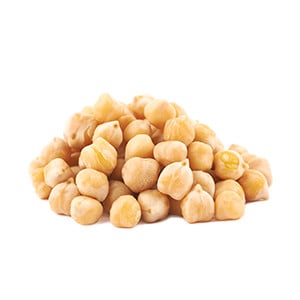Chickpea

Chickpea
Cicer arietinum
Plant family
Legumes (Fabaceae)
Season Overview
Propagating
Planting
Harvest
J
F
M
A
M
J
J
A
S
O
N
D
Details
Light requirement
Sunny
Water requirement
Dry
Soil
Light (sandy)
Nutrient requirement
Low
Plant distance
20 cm
Row spacing
30 cm
Seeding depth
3 cm
Instructions
The season for this plant is over. The following instructions are for the next season.
End of April
Sowing
End of April
Cover
Every week
Beginning of May
Thinning
Description
Chickpea is a species of crop in the legume family. The annual plant reaches heights of up to 1 meter/1.1 yd. On it grow the pods, which are about 3 cm/1.2 in in size. In them: 2 seeds, which we know as chickpeas. The chickpea is very frugal. Although it is cultivated more in subtropical areas, it is possible to grow it also in our latitudes. There are two groups of chickpeas. Kabuli are slightly larger, beige chickpeas. Desi, on the other hand, are darker, smaller and yellow inside. Here, the Kabuli type is more preferred. Like other legumes, it is a good green manure, as it accumulates nitrogen in the soil.
Origin:
At least 8,000 years ago, cultivation begins in Asia Minor. From there it reaches the Mediterranean region and India.
Growing tips
In the Central European climate, it takes an average of 90 to 100 days until harvest. Therefore, the earlier the better! Start with a cultivation in the middle / end of April. Direct sowing outdoors is possible from mid-May, after the last night frost. Chickpea likes light and loose soil. Loosen the soil before sowing or planting the seedlings. To prevent unwanted herbs, a layer of mulch helps. If one or the other herb does make it, you should weed it. About 8 to 12 weeks after sowing the plants are ready for harvest. You can tell by the yellow color of the pods. Take the whole plant out of the ground and hang it upside down. This will allow the seeds to ripen and dry. How easily the seeds fall out of the pod depends on the variety. These dried chickpeas can then be stored for 4 to 5 years.
Companion Plants
Antagonistic Plants
Diseases
No diseases
Pests
Pea leaf weevil
Olive Brown Pea Moth
Pea aphid